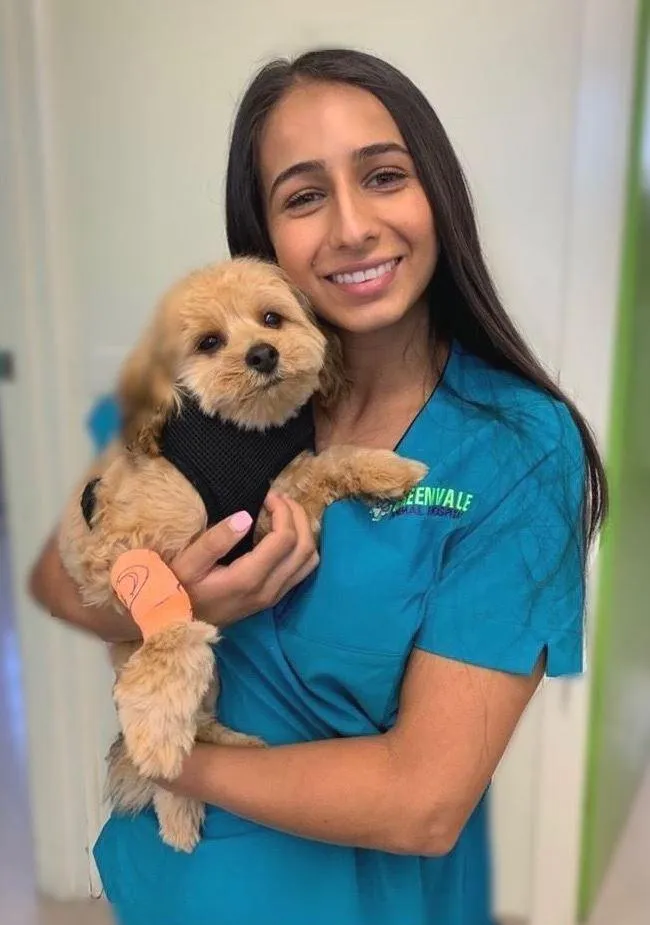BLOG

Emergency Surgery and First Aid Advice from Dr. Chanel Samo
"I always advise clients to prepare a quiet space at home where their pet can recover after surgery. It’s also important to have post-op care instructions and medications ready."
- Dr. Chanel

Getting to Know Dr. Chanel Samo: From General Practitioner to Surgery Specialist
Dr. Samo is a general practitioner with a deep passion for surgery. She initially considered focusing on veterinary medicine but discovered her love for surgery soon after entering the field.
Dr. Samo: "When I started performing surgeries, I realised that’s what I wanted to pursue. The hands-on nature and the problem-solving challenges of surgery really resonated with me."
Dr. Samo's love for surgery, especially orthopedic procedures like knee reconstructions and fracture repairs, developed through her experiences at Greenvale, where she’s been a team member since 2019.
Common Surgical Emergencies in Pets: What You Need to Know
Pet emergencies can be terrifying for owners, but knowing what to expect can help you act swiftly. Dr. Samo shares some of the most common surgical emergencies she encounters in her practice and offers tips on what pet owners should watch for.
1. Pyometra (Infection of the Uterus)
Pyometra is a life-threatening infection in the uterus of unspayed female dogs and cats. Symptoms can include:
Lethargy
Vomiting
High fever
Distended abdomen
Dr. Samo: “These pets come in severely ill. We must remove the infected uterus surgically to save their lives.”
2. Urinary Blockages in Cats
Urinary blockages in male cats can quickly become life-threatening if untreated. Symptoms to watch for include:
Straining to urinate
Frequent trips to the litter box with little output
Lethargy or vomiting
This condition requires immediate veterinary intervention to unblock the urethra and restore normal urination.
3. Splenic Tumors in Dogs
Older dogs sometimes develop tumors on their spleens, which can rupture and cause internal bleeding. Symptoms may include:
Sudden weakness
Pale gums
Bloated abdomen
Collapse
Splenectomies (removal of the spleen) are often needed to save the dog’s life.
A Memorable Case: Vito the Bulldog Defies the Odds
One of Dr. Samo’s most memorable cases involved Vito, a bulldog who presented with vague symptoms of weakness and pale gums. After running tests, it was discovered that Vito had a splenic tumor, which was causing internal bleeding.
Dr. Samo: "We performed an emergency splenectomy, and although the tumor was malignant, Vito defied the odds and is thriving two years later. His survival time has far exceeded what we expected."
Vito’s case underscores the importance of thorough diagnostics and quick surgical intervention in emergencies.
Preparing Your Pet and Yourself for Surgery
Facing surgery can be stressful for both pets and their owners. Dr. Samo provides helpful advice on how to prepare emotionally and practically for surgical procedures.
Setting Expectations
Dr. Samo emphasizes the importance of clear communication. Discuss with your vet:
The purpose of the surgery (curative, palliative, preventative)
The potential risks involved, especially for older pets or those with pre-existing conditions
The cost and recovery time
Post-Surgery Care
If your pet is undergoing surgery, make sure you’re prepared with:
A quiet, contained area for recovery (such as a crate or playpen)
Necessary medications and follow-up care instructions
A plan for follow-up vet visits
Dr. Samo: "You want to make sure the pet is as comfortable as possible after surgery. Limiting their movement can prevent further injury and allow them to heal faster."
Top Tips for Pet Emergencies: What to Do Before You Get to the Vet
Dr. Samo offers four essential tips for triaging your pet during an emergency:
1. Remain Calm
In an emergency, the best thing you can do for your pet is stay calm. Panicking can lead to mistakes or put you and your pet in further danger.
Dr. Samo: "It’s important to remain calm. Avoid speeding on the way to the clinic, and don’t try to capture a snake if your pet has been bitten—take a photo instead."
2. Check Vital Signs
Assess your pet’s vital signs to understand the severity of the situation:
Check for breathing and heartbeat by cupping their chest
Look at the gum color (pink is normal; pale or blue indicates an emergency)
Test for responsiveness by tapping their eyes for a blink reflex
3. Control the Situation
Limit movement in cases of fractures or snake bites to avoid worsening the injury. If there is active bleeding, apply firm pressure to the wound.
Dr. Samo: "For major bleeding, apply digital pressure or a tourniquet if you know how. Immobilize the pet if you suspect a fracture to prevent further damage."
4. Seek Immediate Veterinary Care
Even if your pet seems okay, it's crucial to have them checked by a vet after any traumatic event. Symptoms of toxins, for example, may take hours or days to appear.
Dr. Samo: "It’s better to be safe than sorry. Sometimes symptoms are delayed, so even if your pet seems fine, it’s important to have a vet examine them."
How to Bandage a Pet’s Wound Before Reaching the Vet
If your pet has a laceration, here’s a step-by-step guide to bandaging them safely:
Apply Pressure: Use a clean cloth, gauze, or even a T-shirt to apply pressure to the wound for 2–5 minutes.
Wrap the Wound: Gently wrap the wound with gauze or a soft bandage, ensuring it’s tight enough to stop the bleeding but not so tight that it restricts blood flow (use the "two-finger rule" to check).
Avoid Bandaging Over Fractures: If you suspect a broken bone, do not bandage the area—immobilise the limb instead and get your pet to the vet.
Dr. Samo: "Bandaging can help stop bleeding, but avoid wrapping too tightly, and never bandage a suspected fracture without veterinary supervision."
Avoiding Common Mistakes During a Pet Emergency
Pet owners often make mistakes during emergencies. Here’s how to avoid the most common errors:
Don’t Panic: Stay calm and make rational decisions.
Call Ahead: Let the clinic know you’re coming to ensure they’re prepared.
Avoid Dr. Google: While researching symptoms is tempting, trust your vet’s advice over online information.
Don’t Delay Treatment: Always seek professional care, even if the symptoms seem mild.
Dr. Samo: "Delaying care or self-medicating without consulting a vet can lead to worse outcomes. Call your vet or an emergency clinic immediately for advice."
Be Prepared: How Pet Owners Can Get Ready for Emergencies
No one can predict emergencies, but you can prepare. Dr. Samo offers the following advice for being ready:
Know your pet’s normal: Familiarise yourself with their normal behaviours, respiratory rates, and gum colour.
Emergency fund: Have pet insurance or an emergency savings account to cover unexpected medical costs.
Pet first aid kit: Keep a kit on hand, especially if you travel or spend time in remote areas. It should include bandages, antiseptic, and tick removal tools.
Pet cameras: Use cameras to monitor your pet when you’re not home, which can help identify when an emergency occurs.
Dr. Samo: "Pet cameras can be a fun way to check in on your pet, but they can also alert you to emergencies like accidents or illnesses while you’re away."
Final Thoughts
Dr. Samo’s expertise and advice are invaluable for any pet owner looking to be better prepared for emergencies. The key takeaway? Stay calm, act quickly, and seek professional veterinary care when needed. For more expert advice and practical tips, tune in to the full podcast episode with Dr. Chanel Samo at pawsitivepet.com.au/podcast.
If you’re a veterinary expert or pet care professional and would like to be featured on the podcast, you can book a guest spot here.
Tags:
#PetFirstAid #EmergencyVetCare #PetSurgery #PetHealth #VeterinaryTips #DogFirstAid #CatCare #PawsitivePet #DrChanelSamo
Call 03 8364 8984
Email: Hello@pawsitivepet.com.au
Site: www.pawsitivepet.com.au

